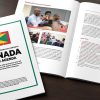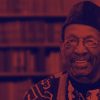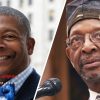We meet today in the vast shadow of the Rev. Dr. Martin Luther King Jr. and that is fitting for much like his contemporary, Min. Malcolm X, he had the capacity to grow beyond his social, cultural, religious and even class programming.
But before we go deep, it is fitting that we thank Dr Tanisha Ford and Dr Hakima Abbas, your forum co-chairs of this event, for their kind invitation; and to our fellow forum contributors, Dr. Johanna Fernandez, Alexis Pauline Gumba, Christopher Tinson, Jamilah Wilson, Walidah Imarisha, Noelle Hanrahan, The Cornel West Theory -and others to come.
Thank you, too, to The Feminist Wire, for covering this event.
How does Dr. King’s life inform our discussion of issues that we face today, at the dawn of a new century? Issues as complex and diverse as the LGBT community’s trek and treatment through the criminal justice system; Black women, the nation’s fastest-growing prison population social and systematic violence against Black women and girls; the rape culture that permeates modern day American society; or feminism as a social force which broadens our perspectives of the prison-industrial-complex?
If Dr. King were alive today, he’d be 85 years old.
But, he is not. Yet, his ideas deepened through the experience of movements, and perhaps more importantly, his inspiration, remains.
For the Civil Rights Movement has had a profound impact on the nation, the world and movements to come. But Martin, reared as he was in the bosom of a conservative, privileged, middle class Baptist family, seemed ill-prepared for the topsy-turvy, hurly-burly struggles of the era, when Blacks were compelled to struggle against their racial, class, gender and national oppressions.
Given his background of privilege, he found confident, outspoken, activist women hard to take. This was perhaps best seen in his interactions with activist/organizer Ella Baker. For, let us be clear. Like many, perhaps most men, King was sexist and chauvinistic. As a man of his class, and his profession, he expected deference – especially from women.
Ella Baker a brilliant skillful organizer was unable to defer to any of the spiritual and national leaders of the time. She opposed, on principle, the idea of charismatic leadership, preferring instead, for collective leaders drawn from their work among the people.
She was among the founders of SCLC, founded the Student Non-Violent Coordinating Committee (SNCC), and had traveled the country organizing as field secretary for the NAACP. In Baker’s words, she knew she wouldn’t make it among the ministers of SCLC, explaining:
There would never be any role for me in a leadership capacity with SCLC. Why? First, I’m a woman. Also, I’m not a minister. And secondŠI knew that my penchant for speaking honestlyŠwould not be well tolerated. The combination of the basic attitude of men, and especially ministers, as to what the role of women in these church setups is -that of taking orders, not providing leadership – and the Šego problems involved in having to feel that there is someone whoŠhad more information about a lot of things than they possessed at the time.
This would never have lent itself to my being a leader in the movement there (Dyson 195).”
King felt “uncomfortable” around Baker, and other women of her type. She had a saying: “strong people don’t need strong leaders. (Abu-Jamal 159). She also wasn’t keen on building national organizations, she believed in buildingmovements.
King, as a man transformed by the burgeoning movement around him, tried mightily to adapt to it, but it wasn’t easy. For, like many men, King had a weakness for female flesh. He felt guilty about it, yes -but he indulged, for he couldn’t say no. In this conflict between flesh and spirit, flesh inevitably won out.
Many of us associate Dr. King with his last big movement push: the Poor People’s Campaign.
When he accepted the invite of National Welfare Rights Organization executive director, George Wiley, to address their board, he experienced a rude awakening. For the NWRO board was staffed by women, and they felt offended because they had advanced the idea of a poor people’s campaign, before the SCLC.
When King sat down with the board they shocked him with their aggressiveness, and their radical thinking. When King was given the floor, he stated his ideas, and solicited their support.
NWRO first vice-chair, Etta Horn asked him for his views on Public Law 90-248. King was dumbfounded. NWRO leader Johnnie Tillmon (a woman), told King that Horn “meant the Anti-Welfare Bill, H.R. 12080”, passed by Congress the year before and signed into law by President Lyndon Johnson in January 1967. King, again, had no clue. Tillmon pressed her advantage, asking pointedly, “Where were youŠwhen we were down in Washington trying to get support for Senator Kennedy’s amendments?”
King, the leader of the movement, was helpless before welfare mothers on top of their game. Johnnie Tillmon, seeing him and his staff getting defensive said, “You know, Dr. King, if you don’t know about these questions, you should say you don’t know, and then we could go on with the meeting.” King agreed, saying, “You’re right, Mrs. Tillmon, we don’t know anything about welfare, we’re here to learn.” (Dyson 208-9.
And he did. He listened. He learned.
That learning re-shaped, deepened and broadened his ideas. He outgrew many of his earlier notions, and became, increasingly, socialist in his economic orientation, anti-capitalist, and, quite rare for the time among Black civil rights leaders, deeply anti-war.
While Martin, as preacher, might’ve brought women to church, it must also be said that women, as teachers, took him to school.
For, at the heart, at the very core of both church and the movement, were women. Their faith, their wisdom, their knowledge, their visions of a better tomorrow, fed those expressions, and gave them life.
Martin’s martyrdom may’ve ended his individual existence, but it did not still the movement. For movements spread, grow, deepen and develop. The civil rights movement gave space and life to the Black Liberation movement, the women’s movement, the Latina movement, the gay movement – and beyond. That’s because those democratic energies could not be repressed forever. When King burst through, he opened doors that had been soldered shut in American society.
One of the most radical of the Black Liberation groups to sprout in the post-King period was The Black Panther Party, founded two years before King’s assassination, by two college students. Although assuredly the BPP was weighted with a decidedly macho image, what with the berets the Black leather jackets, and, lest we forget – guns. It was most assuredly, not an all-male collective. Indeed, quite the reverse is true.
The BPP had a majority of female members and a good number of women led local sections or even captaincies in cities. Indeed, the BPP was the only formation of the era to have a woman in complete command of the group (under Elaine Brown) (LeBlanc-Ernest 309).
Was the Black Panther Party sexist? Yes, without question. But within a sexist society, who was not?
If King, with all of his extraordinary education and gifts, was trapped within the dark amber of sexism, what of men who had no such learning, who learned from the streets? That said, the BPP leadership announced at this very time, that it supported women’s liberation- and gay lib, to boot. Party co-founder, Huey P. Newton mused,”ŠMaybe they might be the most oppressed people in society.”
Frankye Malika Adams, from the Brooklyn chapter of the Party, said “Women ran the BPP pretty much. I don’t know how it got to be a male’s party or thought of as a male’s party.” She knew what every male Panther knew, that despite what the newspapers reported, without women, who made sure the work got done, every day, the organization would not have lasted as long, nor did as well, as it did. Period. (Abu-Jamal 164)
Women form the core of movements. They organize, as did Ella Baker. They lead, as did Elaine Brown. They do the work, to make organizations – and movements – work. And given the sexism extant in a capitalist society, it rarely gets reported, much less known.
But the simple truth is that revolution is women’s work. And man’s work. It is the work of all of us, working as comrades. Kathleen Cleaver was a member Baker. She joined the Party, and is today a law professor working against the prison-industrial-complex. Safiya Asya Bukhari was a college student, who was intrigued by the Party Breakfast for Children Program. When she was threatened by cops, she quit college, joined the Party, and later ran the Party’s East Coast organization from the Bronx headquarters. She later led and commanded units of the Black Liberation Army, before she returned to the ancestors.
Martin Luther King, Jr. was made, both literally and figuratively, by women. They educated him, even when he didn’t want to be educated. Again, as Baker stated, “Martin didn’t make the movement; the movement made Martin.”
Progressive and liberatory social movements are energized and sustained by the gifts women bring with them. They broaden our perspectives on issues of women, gender, and how, under capitalism, all within the prisons on capital are exploited, atomized, made to war against each other, to preserve the rulers.
Martin opened doors to rooms he did not know existed; but he did so, with the hope that it would lead to greater social justice, and fairness. In one of his latter speeches before SCLC, King presented a synthesis of his ideas, calling for a radical restructuring of the entire system: “We are called upon to help the discouraged beggars in life’s marketplace. But one day we must come to see that an edifice which produces beggars needs restructuring.” He continued this questioning, openly, in ways he had done privately: “ŠWho owns the oil?…Who owns the iron ore? Why is it that people have pay water bills in a world that is two-thirds water?, King, of 1967, was a different man than that of 1965; a deeper man. Such a man as this would say this:
A nation that would keep people in slavery for 244 years will “thingify” them, make they things. Therefore they will exploit them and poor people generally, economically. And a nation that will Eexploit will have to have foreign investmentsŠand will have to use its military might to protect them.
All of these problems are tied together (Dyson 84). It is a measure of some irony that King couldn’t bring himself to work closer with one of the most talented organizers of the era: Ella Baker. For, some 30 years before her career as a civil rights organizer bloomed, she co-wrote, with colleague, Marvel Cooke, a remarkable article published in the NAACP journal, The Crisis, which revealed the venal nature of capitalism for poor Black women in Harlem.
They wrote: Not only is human labor bartered and sold for the slave wage, but human love is also a marketable commodity. Whether it is labor or love, the women arrive as early as eight am and remain as late as one pm, or until they are hired. In rain or shine, hot or cold, they wait to work for ten, fifteen, and twenty cents per hour. [Zinn 404]
This, the naked face of capitalism, where one sells their flesh to eat, was an insight that Baker knew, but it took a lifetime of King to glimpse. Capitalism eats its own, for there are no Chinese walls, nor sacred barriers – it is buy and sell – money -trading as the highest value of life. It shows us all how far the Movement has yet to go.
Sources
· Abu-Jamal, Mumia, WE WANT FREEDOM, A Life in the Black Panther Party, (Cambridge: Seven Stories Press, 2004)
· Dyson, Michael Eric, I May Not Get There With You: The True Martin Luther King (New York: Touchstone, 2000)
· Garrow, David E. Bearing the Cross: Martin Luther King. Jr. and the Southern Christian Leadership Conference (New York: Harper Collins, 1986)
· LeBlanc-Ernest, Angela D., “The Most Qualified Person to Handle the Job: Black Panther Party Women, 1966 – 1982, “fr. Charles E. Jones, ed. The Black Panther Party Reconsidered (Balt., MD: Black Classic Press, 1988) (citing Bobby Seale, A Lonely Rage: The Autobiography of Bobby Seale, (New York Times Bks., 1978
· Zinn, Howard, A People’s History of the United States (New York: Harper Collins, 1980-2003











![AEO, Ras Kass, Nkechi Taifa, Kymrence Young & Tricky Trev.) (feat. Young RJ [Slum Village], Ras Kass, Nkechi Taifa & Kymrence Young)](https://ibw21.org/wp-content/uploads/2024/12/organizing-anthem-AEO-Agitate-Educate-Organize-1600x900-1-100x100.jpg)


